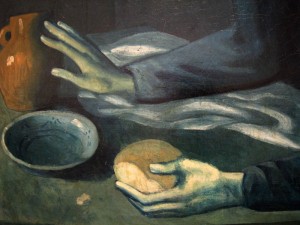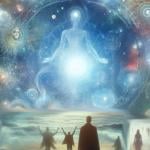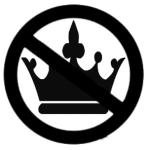tomorrow
when I
go down to Goodmorning and
How are you
what I really need is this bread of the stories, of the songs . . .
–Pablo Neruda, in The Sea and the Bells
Bread is so much a part of the stories of Easter we hardly notice it. There are so many extravagant details, after all, and bread is ordinary. Yet when Jesus appears to people, bread is there . And his final request was that we think of him as the bread that sustains us in our journey to freedom and the promised land.
 This story in John, the breakfast-on-the-beach story, is in some ways the loveliest Easter tale. Breakfast on the beach is such a delightful thing, and there’s a charcoal fire, roasted fish, warm bread . . . and Jesus, feeding his friends. Peter adds to our delight by being so overcome with joy when he sees Jesus on the shore — he has been doing the hard work of hauling trawler nets for hours, in fact, the whole night, and he stripped down for the sweaty work. In his excitement, he puts his clothes on, then plunges from the boat into the water, to get to the shore and to Jesus.
This story in John, the breakfast-on-the-beach story, is in some ways the loveliest Easter tale. Breakfast on the beach is such a delightful thing, and there’s a charcoal fire, roasted fish, warm bread . . . and Jesus, feeding his friends. Peter adds to our delight by being so overcome with joy when he sees Jesus on the shore — he has been doing the hard work of hauling trawler nets for hours, in fact, the whole night, and he stripped down for the sweaty work. In his excitement, he puts his clothes on, then plunges from the boat into the water, to get to the shore and to Jesus.
All night the nets had been empty. Their arms, backs, and hearts all ached. And then a stranger called to them to try the other side of the boat. As if that could make a difference. As if they hadn’t tried everything already. As if a stranger knew better than they how to fish these waters. As if the emptiness were not their lot. As if their hunger could be filled.
 Easter comes, not as an answer, but far more humanly than that. Easter comes to our hunger, to the hunger of the heart and of the stomach. At the inn at Emmaus, bread is broken, and Easter comes. In the upper room, when some think he is a ghost, Jesus eats a fish. And on this beach, at dawn, Jesus is cooking fish. And there is bread.
Easter comes, not as an answer, but far more humanly than that. Easter comes to our hunger, to the hunger of the heart and of the stomach. At the inn at Emmaus, bread is broken, and Easter comes. In the upper room, when some think he is a ghost, Jesus eats a fish. And on this beach, at dawn, Jesus is cooking fish. And there is bread.
From his birth in a town whose name, Bethlehem, means ‘house where bread is baked’ to his last supper, where he gives them bread and says it is his life he is sharing, bread and their hunger have been part of everything he has said and done. In his human life, he sometimes fed bread to 5000 at a time. And in his Easter life, he has fed billions. This does not stop: their hunger and his feeding. This will go on. He calls them to it: Feed my lambs.
In Orthodox churches, bread is central to Easter celebrations. There are Easter breads woven with colored eggs baked into them, and Easter breads shaped into crosses and doves, and Easter breads decorated with flowers. In Italy bread is eaten with chocolate. And in Russia and Greece even the Eucharistic bread, the wafers and small loaves, have honey added to them in celebration.
 The work of feeding the hungers of the world awaits us as Easter winds down, and as we gather for the gift of Spirit that will fuel our energy for feeding the emptiness of the long nights of the human soul.
The work of feeding the hungers of the world awaits us as Easter winds down, and as we gather for the gift of Spirit that will fuel our energy for feeding the emptiness of the long nights of the human soul.
Years ago now, in a church in Massachusetts, a man gave me a recipe for Eucharistic bread, a recipe he had received in his two years as a volunteer with the Jesuits in the third world. A committed Catholic, he had returned to the US and fallen in love with a Protestant woman. When I met him, they had three children, one with Down syndrome, and they lived in a house full of conversation about faith and life, and attended both mass and morning worship.
 The recipe became a staple for my Protestant church, made for our communions by families who baked it together, a chance for parents and children to talk about communion. The children decorated the unbaked dough with fish or crosses or doves or their handprints. We liked it that this bread was being shared around the world, and on any given Sunday, we knew that Christians were sharing it in outdoor churches and in home churches, on altars, tables, anywhere where there was a hunger that had not been filled . . .
The recipe became a staple for my Protestant church, made for our communions by families who baked it together, a chance for parents and children to talk about communion. The children decorated the unbaked dough with fish or crosses or doves or their handprints. We liked it that this bread was being shared around the world, and on any given Sunday, we knew that Christians were sharing it in outdoor churches and in home churches, on altars, tables, anywhere where there was a hunger that had not been filled . . .
Here, then, is the recipe, for Jesuit Volunteer Corps Communion Bread:
1 ½ cups wheat flour
½ cup white flour
¾ tsp salt
¾ tsp baking soda
2 heaping Tbsp margarine or butter
¾ cup cold water
3 Tbsp honey
Mix dry ingredients. Add margarine or butter. Blend well. Add water and honey. Knead until the mixture is a good texture. Shape into a round, flat loaf. Score with a cross, fish, dove, etc. (Or all of them!) Bake at 350 degrees for 20-24 minutes, or longer if needed, till bread isn’t doughy. I like to make two loaves, one to break up, and one for the minister to break in the service.
The place God calls you to is the place where your deep gladness and the world’s deep hunger meet, wrote Frederick Buechner. That place is an Easter beach, where day is breaking in your life, and there is bread, waiting for you.
_________________________________________________
Illustrations:
1. Still Life with Wine, Bread, Fish, Claesz, Peter, 1642, Museum of Fine Arts, Boston. Vanderbilt Divinity Library, Art in the Christian Tradition
2. James and John on Easter Morning, Burnand, Eugene, 1898, Musee d”Orsay, Paris. Vanderbilt Divinity Library, Art in the Christian Tradition
3. The Bread Line, 1872, Moscow, Mjassojedow, Grigorij Grigorjewitsch. Vanderbilt Divinity Library, Art in the Christian Tradition
4. Eucharistic Bread and Fish, Catacombs, 3rd c. Rome, Italy. Vanderbilt Divinity Library, Art in the Christian Tradition
5. The Blind Man’s Bread, Pablo Picasso, 1903. Metropolitan Museum of Art, NY. Vanderbilt Divinity School Library, Art in the Christian Tradition.












